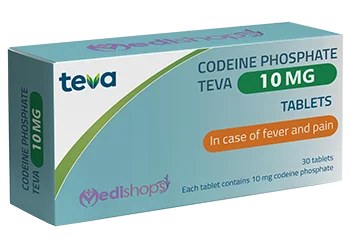
Codeine 10 mg is a well-known drug that is mainly used for pain relief and coughing properties. Although it provides significant benefits for people suffering from moderate pain or persistent cough, it also carries potential risks, especially when it is not used responsibly. In this article, we will find out what codeine is, its medical use, possible side effects, and the risk of addiction and abuse. It is necessary to consider codeine as a treatment option for everyone to understand the balance between the benefits and the dangers.
What is Codeine?
Codeine 10 mg is an opioid that falls under the category of intoxicating painkillers. It is taken from the chemical opium poppy plant and is usually used in prescription medications for pain management. It can be combined with other medications such as acetaminophen or ibuprofen to increase pain-relieving effects.
Although it is considered a milder opioid compared to other people such as morphine or heroin, codeine still carries the ability to abuse and addiction. It is available in different forms, such as in combination with tablets, syrups, and other medicines, and it works by affecting the central nervous system.
Medical Uses of Codeine
- Pain relief: It is often prescribed to handle moderate pain. It is commonly found in combination products for conditions such as arthritis, muscle pain, or surgical recovery. By dulling pain signals in the brain, it provides relief for conditions that are not serious enough to the need for strong opioids.
- Cough oppression: One of the most important uses for codeine is a syrup over-the-counter (OTC) cough pressing. It works by reducing the urge to cough, it creates a remedy for dry, persistent cough that cannot respond to other treatments.
- Combination Medicines: It is often paired with other painkillers, such as acetaminophen or aspirin, to treat pain. This combination can help increase the efficiency of pain relief without requirements for high codeine doses.
How Codeine Works in the Body
Codeine 10 mg works by binding opioid receptors in the brain and spinal cord. These receptors are part of the central nervous system and play a role in the perception of pain. When codeine binds these receptors, it changes how the body considers pain, reducing pain sensitivity.
For its cough effects, the codeine from the brain that is responsible for controlling the cough reflex works effectively to reduce the body’s desire for the body. This Tantric Codeine pain management creates a powerful tool in both parts and reduces some respiratory symptoms.
Side Effects
While the codeine is effective, it comes with its part of possible side effects. The most common side effects include:
- Drowsiness and temptation
- constipation
- Nausea and vomiting
- Dizziness
In some cases, more serious side effects may occur, such as respiratory depression, especially when the drug is abused or combined with other substances affecting the airways. People with a history of respiratory problems, liver disease, or other medical conditions should be careful when using codeine.
Risk of Addiction and Abuse
As an opioid, it can cause addiction, especially when taken in large doses or for a long time. Regular use of codeine can lead to physical addiction, which means that the body becomes dependent on the substance that should function normally.
Signs of codeine abuse include:
- Increased tolerance: needing higher doses to achieve the same effect
- Cravings for the drug
Abuse of long-time codeine can lead to a series of serious health problems, including liver damage, kidney problems, and in severe cases, overdose.
The Role of Codeine in Treatment Plans
It is usually determined as part of a large treatment plan, especially when handling conditions such as moderate pain or chronic cough. This is usually recommended when other medications are insufficient. However, doctors carefully monitor use to avoid the risks associated with the use of opioids for a long time. Patients need to follow the doctor’s guidelines to reduce the risk of abuse.
Alternatives to Codeine for Pain and Cough
While codeine is an effective alternative for pain and coughing, there are many options. For pain relief, medications such as Tramadol, Pregabaline, or physical therapy may be suitable. For cough suppression, non-opioid medicines such as dextromethorphan can provide relief without the risk of addiction.
How to Safely Use It
To avoid the risks of misuse, It should be used strictly as prescribed by a healthcare provider. Patients should never exceed the recommended dose and always consult a physician before combining codeine with other medications or drugs.
What Happens When You Overdose on Codeine?
If not treated immediately, an overdose of codeine can be fatal. Symptoms of overdose include:
- Severe drowsiness
- Slow or difficult breathing
- Unresponsiveness
- Cold or clammy skin
When it comes to overdose, immediate medical attention is important. Naloxone, an opioid antagonist can be used to reverse the effect of codeine overdose.
Codeine Withdrawal
Withdrawal from codeine can be unpleasant and in some cases dangerous. Withdrawal symptoms include:
- Anxiety
- Irritability
- Sweating
- Muscle aches
A gradual tapering of codeine under medical supervision is the safest way to handle withdrawal.
Conclusion
Codeine 10 mg is still a valuable drug for pain and relief from cough, but it comes with significant risk, especially when abuse is performed. It is important to understand its effects, potential side effects, and risks to use it for everyone. Always follow medical advice and responsibly use codeine to avoid complications.
FAQs
1. Is codeine safe for long-term use?
It is generally safe for short-term use, but long-term use can lead to dependence and other health issues.
2. Can you buy codeine over the counter?
In some countries, low-dose codeine is available without a prescription, but in many places, it requires a doctor’s prescription.
3. What are the signs of codeine addiction?
Signs of addiction include increased tolerance, cravings, and continued use despite negative consequences.
4. Can you drive while taking codeine?
It can cause drowsiness, so it’s advised not to drive while using the medication.
5. How do I safely stop using codeine?
Consult your healthcare provider to gradually taper off codeine to avoid withdrawal symptoms.

